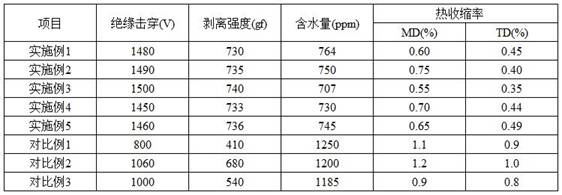A low-moisture ceramic slurry and its application in lithium-ion battery separators
A ceramic slurry and low-moisture technology, which is applied to battery components, separators/films/diaphragms/spacer components, circuits, etc., can solve the problems of many operation steps, difficulty in large-scale mass production, and difficult control. To achieve the effect of solving high water content, which is beneficial to yield rate and electrical properties of products, and good hydrophobic performance
- Summary
- Abstract
- Description
- Claims
- Application Information
AI Technical Summary
Problems solved by technology
Method used
Image
Examples
Embodiment 1
[0044] A low-moisture ceramic slurry, comprising the following raw materials by weight:
[0045] Ceramic powder 25%
[0046] Dispersant 0.5%
[0047] Thickener 17%
[0048] Binder 3.4%
[0049] Wetting agent 0.1%
[0050] Polyvinyl alcohol 0.1%
[0051] Modified sodium polyacrylate 0.1%
[0052] The balance is deionized water A;
[0053] The ceramic slurry is prepared by the following steps:
[0054] 1) According to the weight ratio, disperse the ceramic powder, modified sodium polyacrylate and dispersant into deionized water A, add it to the stirring device, heat to 20°C, stir for 80min to 25r / min and 25r / min. Stir well to obtain mixture A, which is ready for use;
[0055] 2) Add the thickener to the mixture A obtained in step 1), and continue stirring for 20 minutes at a rotation rate of 1000 r / min and a revolution rate of 25 r / min at 20°C until a stable dispersion system B is obtained, for later use;
[0056] 3) Add the binder, the wetting agent and the polyvinyl a...
Embodiment 2
[0074] A low-moisture ceramic slurry, comprising the following raw materials by weight:
[0075] Ceramic powder 26%
[0076] Dispersant 0.6%
[0077] Thickener 18%
[0078] Binder 3.5%
[0079] Wetting agent 0.15%
[0080] Polyvinyl alcohol 0.15%
[0081] Modified sodium polyacrylate 0.2%
[0082] The balance is deionized water A;
[0083] The ceramic slurry is prepared by the following steps:
[0084] 1) According to the weight ratio, disperse the ceramic powder, modified sodium polyacrylate and dispersant into deionized water A, add it to the stirring equipment, heat to 23 °C, and stir for 90 min to Stir well to obtain mixture A, which is ready for use;
[0085] 2) Add the thickener to the mixture A obtained in step 1), and continue stirring for 25 minutes at a rotation rate of 1100 r / min and a revolution rate of 28 r / min at 23°C until a stable dispersion system B is obtained, for use;
[0086] 3) Add the binder, the wetting agent and the polyvinyl alcohol to the di...
Embodiment 3
[0104] A low-moisture ceramic slurry, comprising the following raw materials by weight:
[0105] Ceramic powder 27%
[0106] Dispersant 0.7%
[0107] Thickener 19%
[0108] Binder 3.6%
[0109] Wetting agent 0.2%
[0110] Polyvinyl alcohol 0.2%
[0111] Modified sodium polyacrylate 0.3%
[0112] The balance is deionized water A;
[0113] The ceramic slurry is prepared by the following steps:
[0114] 1) According to the weight ratio, disperse the ceramic powder, modified sodium polyacrylate and dispersant into deionized water A, add it to the stirring equipment, heat to 25°C, and stir for 100 min to Stir well to obtain mixture A, which is ready for use;
[0115] 2) Add the thickener to the mixture A obtained in step 1), and continue stirring for 30 minutes at a rotation rate of 1200 r / min and a revolution rate of 30 r / min at 25°C until a stable dispersion system B is obtained, for use;
[0116] 3) Add the binder, the wetting agent and the polyvinyl alcohol to the disp...
PUM
 Login to View More
Login to View More Abstract
Description
Claims
Application Information
 Login to View More
Login to View More - R&D
- Intellectual Property
- Life Sciences
- Materials
- Tech Scout
- Unparalleled Data Quality
- Higher Quality Content
- 60% Fewer Hallucinations
Browse by: Latest US Patents, China's latest patents, Technical Efficacy Thesaurus, Application Domain, Technology Topic, Popular Technical Reports.
© 2025 PatSnap. All rights reserved.Legal|Privacy policy|Modern Slavery Act Transparency Statement|Sitemap|About US| Contact US: help@patsnap.com

